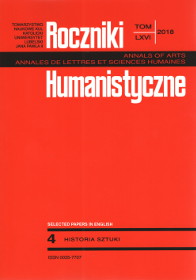King, Prophet or Priest? The Charisma of a Consecrated Ruler in the Ottonian Miniatures: Ideological Contents and the Functions of Presentations of the Saxon Dynasty Emperors
Abstract
The Polish version of the article was published in “Roczniki Humanistyczne,” vol. 64 (2016), issue 4.
The article focuses on miniatures of an enthroned emperor. These are: the miniature showing Otto II from the Registrum Gregorii (Chantilly, Musée Condé, MS 14), two miniatures from the so-called Gospels of Otto III (Munich, Bayerische Staatsbibliothek, Clm. 4453)—one showing Otto III and the other one showing the allegories of the provinces of the empire, two miniatures (Otto II and the provinces) contained in the Gospels bound in the code also containing works by Flavius Josephus (Bamberg, Staatsbibliothek, Class. 79) and the miniature with the figure of Otto III found in the Liuthar Gospels, also called the Aachener Evangeliars (Aachen, Domshatz). The pictures were studied by Percy Ernst Schramm, Piotr Skubiszewski, Henry Mayr-Harting, Wolfgang Christian Schneider, Ludger Körntgen, Hagen Keller and Eric Palazzo. Exaltation of the emperor has its precedents in the Carolingian art. Placing the royal space in the upper gallery of the Palatine Chapel in Aachen and the miniature showing the exalted Charles the Bald in the Count Vivian Bible witness to the Carolingian approach to the person of the ruler. The sources of the consecration of an exalted ruler over bishops and princes in miniatures should be looked for in the theological-political views of the epoch. Hincmar, Archbishop of Reims, Smaragdus, Alcuin and Thietmar of Merseburg define the ruler as one chosen and anointed by God for ruling the people. However, the exaltation of the ruler should be looked for in the liturgy of the consecration of the king that is documented in the Pontifical Romano-Germanique. The most important act of this liturgy is the anointing, unction, practiced during the consecration prayer. The image of the enthroned emperor mirrors the moment of the liturgy in which the consecrated one, after being anointed and handed the regalia, ascends the throne in the apse, led there by the metropolitans and princes. The anointing is derived from the Old Testament consecration of kings, prophets and judges. However, the consecration of a king is different from the consecration of a bishop, presbyter or deacon, so defining the anointed king as a sacerdos is unjustified. The image of the bishop consecrated and exalted on the pattern of a ruler also appears in the Ottonian art—in the Psalterium Egberti and the Codex Egberti. The analysed and interpreted pictures are put in the context of the set of Christological miniatures found in liturgical books where the mentioned miniatures appear. It follows from the above statements that the figure of the ruler as one who listens to God’s Word, and the figure of the ruler who is not a type of Christ, but should be shaped on the pattern of Christ, are the basic features of the contents of all the four miniatures.
References
Bayer, Clemens M.M. “Untersuchungen zum ottonischen Evangeliar der Aachener Domschatzkammer.” Aachener Kunstblätter 54/55 (1986/87): 33–46.
Das Evangeliar Ottos III. Clm 4453 der Bayerischen Staatsbibliothek. Hrsg. von Florentine Mütherich, Karl Dachs. München–London–New York: Prestel, 2001.
Els, Josef. “Das Aachener Liuthar-Evangeliar. Zur Bedeutung des Aachener Evangeliars Ottos III.” Rheinische Heimatpflege 48 (2011): 181–194.
Fried, Johannes. Otto III. und Boleslaw Chrobry. Das Widmungsbild des Aachener Evangeliars, der “Akt von Gnesen” und das frühe polnische und ungarische Königtum. Eine Bildanalyse und ihre historischen Folgen. Stuttgart–Wiesbaden: F. Steiner, 1989.
Hoffman, Konrad. “Die Evangelistenbilder des Münchener Otto-Evangeliars (CLM 4453).” Zeitschrift des Deutschen Vereins für Kunstwissenschaft 20 (1966): 17—46;
Hoffmann, Konrad. “Das Herrscherbild im Evangeliar Ottos III” (Clm 4453).” Frühmittelalterliche Studien 7 (1973): 324–341.
Kahsnitz, Rainer. “Ungewöhnliche Szenen im Aachener Liuthar-Evangeliar. Ein Beitrag zum Problem des christologischen Zyklus der Reichenauer Buchmalerei.” In Buchschätze des Mittelalters, edited by Klaus Gereon Beuckers, 63–91. Regensburg: Schnell & Steiner, 2011.
Katalog der illuminierten Handschriften der Staatsbibliothek Bamberg, Bd. I, 1: Die Handschriften des 8. bis 11. Jahrhunderts der Staatsbibliothek Bamberg, 1. Teil: Texte/ beschrieben von Gude Suckale-Redlefsen. Wiesbaden: Harrassowitz, 2004.
Keller, Hagen. “Das neue Bild des Herrschers: zum Wandel der “Herschaftsrepräsentation” unter Otto dem Großen.” In Ottonische Neuanfange: Symposion zur Ausstellung “Otto der Grosse, Magdeburg und Europa”. Hrsg. von Bernd Scheidmüller und Stefan Weinfurterm, 189–211. Mainz am Rhein: Von Zabern, 2001.
Körntgen, Ludger. “König und Priester: Das sakrale Königtum der Ottonen: zwischen Herschaftstheologie, Herschaftspraxis und Heilsorge.” In Die Ottonen: Kunst-Architektur-Geschichte. Hrsg. von Klaus G. Bauchner, Johannes Cremer und Michael Imhof, 51–61. Petersberg: Michael Imhof, 2002.
Körntgen, Ludger. Königsherrschaft und Gottes Gnade: zu Kontekst und Funktion sakraler Vorstellungen in Historiographie und Bildzeugnissen der ottonisch-frühsalischen Zeit. Berlin: Akademie-Verlag, 2001.
Kuder, Ulrich. “Liuthar-Evangeliar.” In Bernward von Hildesheim und das Zeitalter der Ottonen. Ausstellungskatalog Hildesheim 1993, Bd. II, hrsg. von Michael Brandt, Arne Eggebrecht, 84–87. Mainz: Zabern, 1993.
Mayr-Harting, Henry. Ottonian book illumination, I-II. London: Harvey Miller, 1999.
Mayr-Harting, Henry. Ottonian Book illumination, part II. London: Miller, 1999.
Nordenfalk, Carl. “Archbishop Egbert’s Registrum Gregorii.” In Studien zur mittelalterlichen Kunst 800-1250. Festschrift für Florentine Mütherich zum 70. Geburtstag, 87–100. München: Prestel-Verlag, 1985.
Schneider, Wolfgang Ch. “Imperator Augustus und Christomimetes: Das Selbstbild Ottos III in der Buchmalerei.” In Europas Mitte 1000: Handbuch zur Ausstellung, Bd. II. Hrsg. von Alfried Wieczorek und Hans M. Hinz, 798–886. Stuttgart: Theiss, 2000.
Schramm, Percy Ernst. “Das Herrscherbild In der Kunst des frühen Mittelalters.” In Vorträge der Bibliothek Warburg, 145–224. Berlin: Leipzig, 1922–1923.
Schramm, Percy Ernst. Kaiser, Rom and Renovatio, Bd. I–II. Berlin: Leipzig, 1929.
Skubiszewski, Piotr. “W służbie cesarza, w służbie króla. Temat władzy sztuce ottońskiej.” In Funkcja dzieła sztuki: materiały Sesji Stowarzyszenia Historyków Sztuki, Szczecin, listopad 1970. Warszawa: PWN, 1972.
Weilandt, Gerhard. “Das Huldigungsbild im Evangeliar Kaiser Ottos III. in seinem geschichtlichen Zusammenhang.” Geschichte in Wissenschaft und Unterricht 42 (1991): 535–548.
Copyright (c) 2018 Roczniki Humanistyczne

This work is licensed under a Creative Commons Attribution-NonCommercial-NoDerivatives 4.0 International License.





